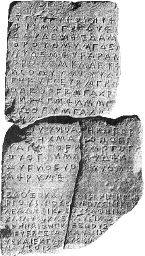| Group | Anatolian (with Hittite, Luwian etc.), Late Anatolian (with Lydian, Lycian, and Sidetian) |
| Geography | Was spoken in Caria, a district on the south-west of Asia Minor where Ephesus is situated |
| History | Carians were people who were well known by Ancient Greek and Roman historians; they recorded that the original inhabitants of this region were pushed inland by an influx of people called Carians. The Carians, who were notable as mercenary soldiers, had been driven from their native islands in the Aegean Sea by invading Greeks. The Greeks also established colonies along the coast of Caria, notably Cnidus and Halicarnassus. In the 6th century BC, Caria was incorporated into the kingdom of Lydia; subsequently, it became a Persian dominion, ruled by Carian kings who were subject to Cyrus the Great. Mausolus was the best known of these monarchs; his widow built the Mausoleum at Halicarnassus, one of the Seven Wonders of the World. Herodot was born also in Halicarnassus. |
| Phonetics | There were 5 simple vowels, a number of diphthongs were forming; the number of consonants was enlarged by the addition of palatal [n] and [l] sounds. Obviously there were also a few aspirated consonants: [kh], [th], [ph]. Some suppose that many Hittite voiced sounds became unvoiced in Carian. |
| Nominal Morphology | The noun obviously had two genders (common and neuter) and could be declined, though all case markers were agglutinative and resulted from pronominal suffixes (like -z for the ablative-instrumental case). The system of pronouns include typical Indo-European demonstrative and personal ones (uk 'I', kuo 'which'). |
| Verbal Morphology | The relics of the Carian conjugation found in inscriptions prove that traces of the Hittite verbal structure were preserved here: the past singular marker -un (Hittite -hun, -un), the present 2nd person ending -t from Indo-European *-ti etc. |
| Lexicon | About 200-250 words are known from Carian, most of them are of non-Indo-European origin, though researchers emphasize several exactly Indo-European words. |
| Writing | Carian alphabets |
| Close Contacts | Carian was closer to Lydian than to Lycian, and therefore is considered to be a descendant of Hittite. Close contacts with aboriginal peoples of Asia Minor influenced the language greatly. |
| Sample | tuwanu st.esan kl iot.ulul
slnkolp kovkove dans.
A sacred stele for Iotulv, very respectable, Kovkove built here. |
| Picture |  |
| More info |